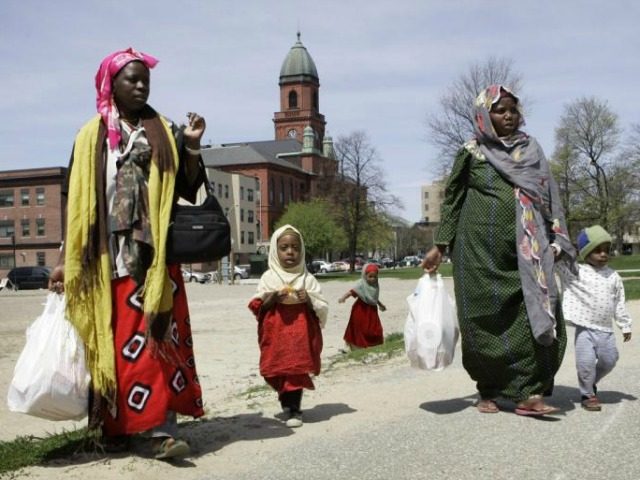By Clara Hinklin
As the Somali Bantu arrive at the place which was to become home, they experienced many challenges. Lewiston, Maine was a small community, set in its ways with locals many would call “quirky”. The transition to living in a village without a single phone to living in a city, in an apartment with electricity was unlike any other change the Somali Bantu had experienced. In her book, Making Refuge: Somali Bantu Refugees and Lewiston Maine, Catherine Besteman writes about her experiences, as an anthropologist, with the Somali Bantu as they navigated life in a new community.
The move from depending on fellow community members, to being more independent and relying on the government for assistance challenged the Somali Bantu’s cultural identity. The families were placed in housing which made their previous lifestyle of openness and community more difficult. They had more complex relationships with people from

Somali women walking with their small children.
their home than what is common for most Americans. The change of life structure created stress for the Somali women, who relied on each other for childcare. The men, who mostly farmed in Somalia, were forced to try to find jobs that were not based on their acquired skill set. During all of the transitioning, the Somali Bantu had to learn how the government worked in The United States. This was very challenging because of the difference of government like structure they were accustomed to in Somalia, where the elders held the power and everyone’s voice was heard.
The education system also created challenges for the Somali Bantu. The older children had to leave the home to go to school, leaving the mothers to care for the younger children, the home, and other responsibilities. This was a change from the previous lifestyle of older children helping their mothers during the day. When the children were at school, they faced the challenge of learning English. This would become crucial to their success in Lewiston as many parents would rely on their children to translate for them.
The major challenges that the Somali Bantu faced were racism and rejection. Numerous residents in Lewiston felt that the Somali Bantu were inferior and that they should have not been allowed to live in their community. One of the city’s mayors, Robert Macdonald, spoke publicly about the Somali Bantu’s needing to leave their culture behind and adopt the ways of life that he felt were appropriate. Somali Bantu women were harassed in the streets for the religious headscarf they wear. Young Somali Bantu boys were labeled gang members, even though it was very unlikely they understood what a gang was.

Somali Bantu children being educated on juvenile justice. Photo by Russ Dillingham.
The list of other challenges is seemingly never-ending, and some challenges still have yet to be conquered. The work of Besteman showing the Somali Bantu perspective on their resettlement is a place to start understanding who these people are, in their own words. The media covers pieces of the Somali Bantu struggles but does not work to create a fully encompassing view like an anthropologist does.
Citations:
Leahy, Michael Patrick. “More Federal Money for Somali Refugees in Maine.” Breitbart, 4 Oct. 2016, www.breitbart.com/politics/2016/10/03/federal-money-somali-refugees-maine/.
McIntire, Douglas. “Somali Bantu Youth Learn about Juvenile Justice.” Lewiston Sun Journal, 14 Aug. 2013, www.sunjournal.com/somali-bantu-youth-learn-juvenile-justice/.
Besteman, Catherine. Making Refuge Somali Bantu Refugees and Lewiston, Maine. Duke University Press, 2016.